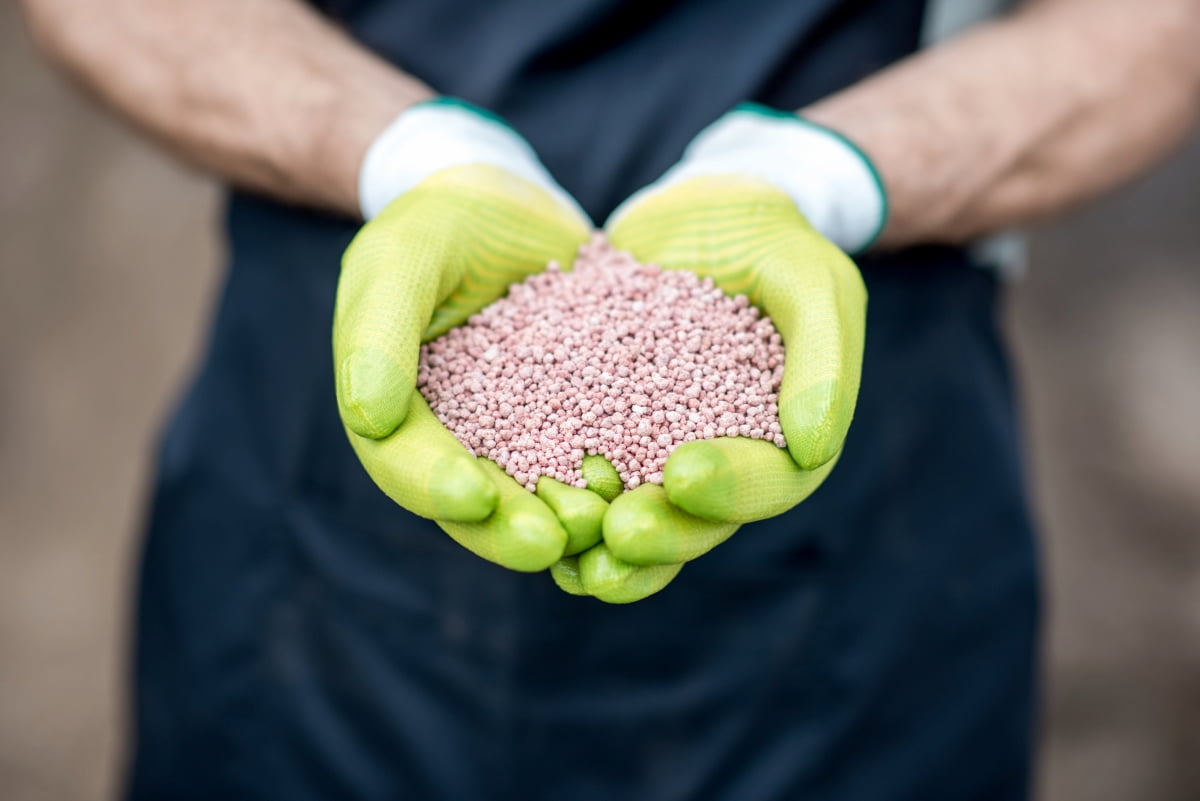Chrysanthemums are popular flowers for their showy blooms and ease of care. Choosing the right fertilizer for your chrysanthemums will promote their growth and health and enhance their bloom. This article will discuss the best fertilizers for chrysanthemums and when to apply them.

Best Fertilizer for Chrysanthemums
Understanding Chrysanthemums and Their Nutrient Needs
Chrysanthemums are a kind of daisy in the Asteraceae family and are originally from Asia and northeastern Europe. These versatile plants are available in various colors, shapes, and sizes, making them a staple in gardens and floral arrangements. To flourish, chrysanthemums require adequate nutrients, especially nitrogen (N), phosphorus (P), and potassium (K). These macronutrients are essential for growth, flower production, and overall plant health.
Best Fertilizers for Chrysanthemums
The best fertilizer for chrysanthemums is a balanced, slow-release fertilizer with equal parts of N, P, and K. A fertilizer with an NPK ratio of 10-10-10 or 14-14-14 is ideal for these plants. Additionally, incorporating organic matter such as compost or well-rotted manure into the soil will help improve its structure and provide essential micronutrients. Some popular fertilizer options include:
- Granular Slow-Release Fertilizers: These fertilizers release nutrients gradually over time, providing a consistent supply for your chrysanthemums. They are typically applied at the time of planting and once more during the growing season.
- Liquid Fertilizers: When you need to give your plant a rapid boost in nutrients, liquid fertilizers are best as they are easily absorbed by the plant. To achieve healthy plant growth, dilute a liquid fertilizer with an NPK ratio of 10-10-10 or 14-14-14 as directed by the manufacturer. During the growth season, use every two weeks.
- Organic Fertilizers: Organic fertilizers like compost, well-rotted manure, bone meal, and fish emulsion provide a natural, eco-friendly option for your chrysanthemums. They improve soil structure and promote healthy root development while slowly releasing nutrients.
When to Fertilize Chrysanthemums
Timing is important when it comes to fertilizing chrysanthemums. Applying fertilizer at the right time will ensure plants receive the nutrients they need without overloading them. Here are the key times to fertilize chrysanthemums:
- At Planting Time: Incorporate a slow-release granular fertilizer or organic matter into the soil when planting your chrysanthemums. This will provide an initial supply of nutrients for the plants to establish themselves.
- During the Growing Season: Once your chrysanthemums start actively growing, apply a liquid fertilizer or additional granular fertilizer every two weeks. This will encourage healthy growth and enhance flower production. Stop fertilizing when the flower buds begin to show color to prevent nutrient burn.
- After Blooming: After the chrysanthemums have finished blooming, cut back on fertilizing. Instead, focus on providing adequate water and care to allow the plants to recover and store energy for the next growing season.
How to Apply Fertilizer to Chrysanthemums
Proper fertilizer application is essential to ensure that your chrysanthemums receive the nutrients they need without causing harm. Follow these steps to apply fertilizer correctly:
Granular Fertilizers: Sprinkle the granular fertilizer around the base of the plant, approximately 2-3 inches away from the stem. Avoid applying the granules directly to the stem or leaves, as this could cause burns. Water thoroughly after applying to help the fertilizer seep into the soil.
Liquid Fertilizers: Mix the liquid fertilizer with water according to the package instructions. Apply the solution to the soil around the base of the plant, avoiding the leaves and stems. It’s best to apply liquid fertilizer in the morning or evening to minimize evaporation and maximize absorption.
Organic Fertilizers: Incorporate organic materials into the soil around your chrysanthemums, mixing it well to ensure even distribution. Compost or well-rotted manure can be added directly to the soil. Bone meal and fish emulsion should be mixed with the soil or water before applying.
In case you missed it: The Best Fertilizer for Hyacinth: When and How to Apply

Monitoring Chrysanthemums’ Health and Adjusting Fertilizer Regime
While a balanced fertilizer will provide most of the nutrients your chrysanthemums need, monitoring your plants’ health and adjusting your fertilizing regime as necessary is essential. Yellow leaves could indicate a nitrogen deficiency, while a lack of flowers could point to a phosphorus deficiency. Consider adjusting your fertilizer type or application rate if your chrysanthemums exhibit signs of nutrient deficiency.
Other Factors to Consider
While fertilizing is crucial, it’s not the only factor affecting the health and growth of your chrysanthemums. Paying attention to other factors, such as watering, sunlight, soil quality, and pest control, is also necessary. These plants prefer well-drained soil and full sun exposure. Overwatering or poor drainage can lead to root rot, and too much shade can lead to leggy growth and fewer flowers. Regular pest inspections and appropriate control measures are essential to keep your chrysanthemums healthy.
Fertilizing Established Chrysanthemums
Established chrysanthemums will benefit from a slightly different fertilizing regime than newly planted ones. Apply a balanced liquid or granular fertilizer every two weeks to support growth and flower production during the growing season. When the plants form buds, switch to a low-nitrogen, high-phosphorus fertilizer to encourage blooming. After blooming, scale back the fertilizing to let the plants rest and recuperate.
Fertilizing Chrysanthemums in Containers
Chrysanthemums grown in containers will need more frequent fertilizing as pot nutrients are washed away more quickly with watering. Use a slow-release granular fertilizer at planting time, and supplement with a liquid fertilizer every two weeks during the growing season. Ensure your potting mix is well-draining, as soggy soil can lead to root rot. Similarly, ensure your pot has adequate drainage holes.
Environmental Considerations
When choosing a fertilizer for your chrysanthemums, consider its environmental impact. Excessive use of chemical fertilizers can contribute to nutrient runoff, harming local water bodies. On the other hand, organic fertilizers break down slowly, reducing the risk of nutrient runoff and providing a long-term nutrient supply for your plants. Additionally, organic fertilizers improve soil structure and fertility, promoting a healthier garden ecosystem.
In case you missed it: The Best Fertilizer for Jasmines: When and How to Apply

Conclusion
Choosing the right fertilizer for your chrysanthemums and applying it correctly can significantly impact your plants’ health and flowering. Whether you choose a slow-release granular fertilizer, a quick-acting liquid fertilizer, or an organic alternative, the key is to provide a balanced supply of nutrients, especially nitrogen, phosphorus, and potassium.
Remember to adjust your fertilizing regime based on your plant’s needs, and don’t forget the importance of other care factors, like watering sunlight and pest control. With the right care and attention, your chrysanthemums will reward you with abundant, vibrant blooms.
- Feed Your Flock for Less: Top 10 Tips to Save on Chicken Feed
- Ultimate Guide to Ossabaw Island Hog: Breeding, Raising, Diet, and Care
- Hatching Answers: The Top 10 Reasons Your Chickens Aren’t Laying Eggs
- Eggs and Economics: Breaking Down the Cost of Raising Backyard Chickens
- Defend Your Greens: Proven Methods to Keep Iguanas Out of Your Garden
- Ultimate Guide to Cinnamon Queen Chicken: A Comprehensive Guide for Beginners
- Ultimate Guide to California Tan Chicken: Breeding, Raising, Diet, Egg-Production and Care
- Ultimate Guide to Marsh Daisy Chicken: Breeding, Raising, Diet, and Care
- 10 Types of Chicken Farming Businesses You Can Start for Profits